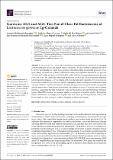Files in this item
Garvicins AG1 and AG2 : two novel class IId bacteriocins of lactococcus garvieae Lg-Granada
Item metadata
| dc.contributor.author | Maldonado-Barragán, A. | |
| dc.contributor.author | Alegría-Carrasco, E. | |
| dc.contributor.author | Blanco, M.M. | |
| dc.contributor.author | Vela, A.I. | |
| dc.contributor.author | Fernández-Garayzábal, J.F. | |
| dc.contributor.author | Rodríguez, J.M. | |
| dc.contributor.author | Gibello, A. | |
| dc.date.accessioned | 2022-05-05T14:30:41Z | |
| dc.date.available | 2022-05-05T14:30:41Z | |
| dc.date.issued | 2022-04-23 | |
| dc.identifier | 279430099 | |
| dc.identifier | 1f4a2e44-e88b-4a10-9d39-95560eeb1330 | |
| dc.identifier | 000794507200001 | |
| dc.identifier | 85128720340 | |
| dc.identifier.citation | Maldonado-Barragán , A , Alegría-Carrasco , E , Blanco , M M , Vela , A I , Fernández-Garayzábal , J F , Rodríguez , J M & Gibello , A 2022 , ' Garvicins AG1 and AG2 : two novel class IId bacteriocins of lactococcus garvieae Lg-Granada ' , International Journal of Molecular Sciences , vol. 23 , no. 9 , 4685 . https://doi.org/10.3390/ijms23094685 | en |
| dc.identifier.issn | 1661-6596 | |
| dc.identifier.other | RIS: urn:C40FF59E61E9EF81801210496DB2489A | |
| dc.identifier.other | ORCID: /0000-0002-4775-346X/work/112711659 | |
| dc.identifier.uri | https://hdl.handle.net/10023/25288 | |
| dc.description | Funding: This research was funded by the Spanish Ministry of Science, Innovation, and Universities, grant number RTI2018-098530-B-I00. The APC was funded by the Spanish Ministry of Science, Innovation, and Universities, grant number RTI2018-098530-B-I00. | en |
| dc.description.abstract | Lactococcus garvieae causes infectious diseases in animals and is considered an emerging zoonotic pathogen involved in human clinical conditions. In silico analysis of plasmid pLG50 of L. garvieae Lg-Granada, an isolate from a patient with endocarditis, revealed the presence of two gene clusters (orf 46–47 and orf 48–49), each one encoding a novel putative bacteriocin, i.e., garvicin AG1 (GarAG1; orf 46) and garvicin AG2 (GarAG2; orf 48), and their corresponding immunity proteins (orf 47 and orf 49). The chemically synthesised bacteriocins GarAG1 and GarAG2 presented inhibitory activity against pathogenic L. garvieae strains, with AG2 also being active against Listeria monocytogenes, Listeria ivanovii and Enterococcus faecalis. Genetic organisation, amino acid sequences and antimicrobial activities of GarAG1 and GarAG2 indicate that they belong to linear non-pediocin-like one-peptide class IId bacteriocins. Gram-positive bacteria that were sensitive to GarAG2 were also able to ferment mannose, suggesting that this bacteriocin could use the mannose phosphotransferase transport system (Man-PTS) involved in mannose uptake as a receptor in sensitive strains. Intriguingly, GarAG1 and GarAG2 were highly active against their own host, L. garvieae Lg-Granada, which could be envisaged as a new strategy to combat pathogens via their own weapons. | |
| dc.format.extent | 12 | |
| dc.format.extent | 1082385 | |
| dc.language.iso | eng | |
| dc.relation.ispartof | International Journal of Molecular Sciences | en |
| dc.subject | Antimicrobial peptides | en |
| dc.subject | In silico analysis | en |
| dc.subject | Zoonotic diseases | en |
| dc.subject | QR Microbiology | en |
| dc.subject | DAS | en |
| dc.subject | SDG 3 - Good Health and Well-being | en |
| dc.subject | MCC | en |
| dc.subject.lcc | QR | en |
| dc.title | Garvicins AG1 and AG2 : two novel class IId bacteriocins of lactococcus garvieae Lg-Granada | en |
| dc.type | Journal article | en |
| dc.contributor.institution | University of St Andrews. School of Medicine | en |
| dc.identifier.doi | https://doi.org/10.3390/ijms23094685 | |
| dc.description.status | Peer reviewed | en |
| dc.identifier.url | https://www.mdpi.com/journal/ijms/special_issues/AntimicrobialPeptides_BiologicalActivity | en |
This item appears in the following Collection(s)
Items in the St Andrews Research Repository are protected by copyright, with all rights reserved, unless otherwise indicated.

